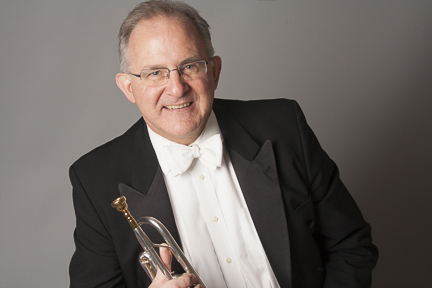832-622-2104
Some comments on my approach to brass playing:
I approach the instrument while singing. Literally, I sing before I play each day. Then I buzz on the mouthpiece, exactly what I had been singing. The next step is to put a “buzz-aid” or B.E.R.P. on the instrument and, fingering the horn, buzz the same way—which is to say, I sing in my head just as I did when I was initially buzzing. Then I put the mouthpiece into the trumpet and play the instrument, continuing to sing the same way in my head. My concentration is on the singing in my head, not what comes out of the trumpet.
It is crucial, even critical, that I maintain that singing state of mind at every step. I don’t noodle or play rote patterns, but choose lyrical pieces for this. I like sight-singing books, such as the little Oxford series. I solfège the notes (movable Do, which tells me where I am in the harmony). This isn’t necessary, as I have students who learn standards from recordings by Frank Sinatra and sing his lyrics as they buzz their mouthpieces. Like solfège, singing lyrics makes use of both sides of the brain, the verbal left side as well as the musical-imaging right side, engaging more of the mind, thus bringing more focus. Besides, singing is just plain healthy, and practicing bringing singing into playing is a big step towards playing easily.
Following a ten-to-fifteen minute session of singing and buzzing simple music, I then spend some time playing slow scales with the same sound I was getting from the (1) singing—(2) buzzing—(3) buzzing on the instrument with a buzz-aid—(4) playing the instrument. From there it’s five or ten minutes of Clarke studies, a flow study, and a nice big fat lyrical study from Concone, Rochut, or Snedecor.
On a day with rehearsals, and that’s most of them, I then pull out what music I’ve been preparing, and touch on a thing or two. Or ten things, some weeks! If I’m not in rehearsal, that’s when I work on a Bousquet ètude. After ten or twenty minutes, it’s time for coffee, then on to more demanding material. The studies of Paudert, Sachse, Charlier, and Walter Smith all come at this point.
The basic underlying foundation for my work is the initial release of the tone, which must be free and unencumbered. Physically, everyone can do this. It’s the same as gently blowing out a candle. But when we pick up a brass instrument, so often we introduce small—or large—compromises of an activity, respiration, which we perform perfectly well in the rest of our lives. It’s a good exercise to simply release the air onto one’s hand, then emulate that when playing the instrument.
I hope these thoughts help you. Above all, get the instrument out and play beautifully!
